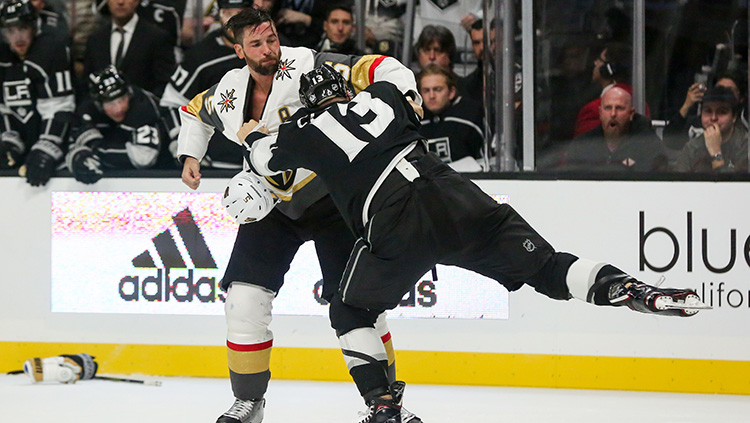Photo: Joshua Lavallee/Icon Sportswire (Getty)
My interest in hockey began with movies. When I was a kid I was obsessed with The Mighty Ducks as Coach Bombay and his young team flew their way to victory together. And who could forget the iconic end-credit sequence to The Mighty Ducks 2 when the cast sang Queen’s “We Are The Champions”?
My knowledge about the sport was limited to film, fighting, consistent play, collisions, and the occasional amazing goal. For those who are new to ice hockey and want to know more than the very, very basics before the 2018-2019 regular season starts on October 3, I’ve done my homework for all of us rookie fans.
Knowing the History
You don’t have to learn the entire background of ice hockey, but a little history lesson doesn’t hurt. The National Hockey League (NHL) was established in 1917 in Montréal, Québec. The league started with four teams and eventually formed the “Original Six” from 1942-1967, consisting of the Montreal Canadiens, Toronto Maple Leafs, Boston Bruins, Chicago Blackhawks, Detroit Red Wings, and the New York Rangers.
Read more on the formation of the league and its early history here.
Learning the Basics
Currently, the league has 31 franchises with 7 in Canada and 24 in the U.S. There are two conferences, the Western Conference and the Eastern Conference, that consist of two divisions each. The Western has the Pacific and Central Divisions, while the Eastern has the Metropolitan and Atlantic Divisions.
No Means No: NHL Wants This Hockey Star To Stop Licking Opponents
Studying the Rules
NHL rules are extensive, but here’s a good starting point: Games are played in a rink divided into three parts known as the defending zone, neutral zone, and the offensive zone. Play lasts for 60 minutes, divided into three 20-minute periods as well as 20-minute intermissions after the first and second periods. A tie game at the end will result in overtime. Rules like icing and offsides can confuse the best of us, but you’ll get the hang of it.
Understanding the Penalties
Punishments for penalties depend on whether the penalty was minor, major, or a misconduct. With minor being the least severe and a misconduct being the most, punishments can range from 2-10 minutes in the penalty box. Additional penalties can be added on if the penalty was severe enough, and only a minor penalty can end early if the other team scores during the penalty time.
Penalties include butt-ending, checking from behind, cross-checking, elbowing, fighting, hooking, interference, kneeing, roughing, slashing, spearing, and tripping.
Fighting
Everyone knows that fighting is synonymous with hockey. Many fans will tell you that fighting is part of what makes the sport enjoyable, like how Nascar fans really only stick around waiting for a crash. Fighting in hockey will always be controversial with opinions on both sides, but as long as the sport continues, so will the brawls.
Positioning
So, who are you even watching on the ice? In hockey, there are five positions: Goaltender, defensemen, center, left wing, and the right wing. Usually, NHL teams will have one goalie, six defensemen, and four each of left wings, right wings, and centers. Unless a team is missing a player for a certain position, players don’t normally switch positions.
Checking Out Minor Leagues
The only hockey game I’ve ever managed to attend was actually a minor league game, and thanks to the smaller venue and cheaper tickets, we were face-to-face with the action a couple rows up from the rink. Minor league fans are as passionate as NHL fans, and the players go hard, determined to continue developing their skills in case they one day get the call to join the big leagues.
Not Just For the Boys: An Inside Look At Professional Women’s Hockey
Watching At Home
When I say watch games at home, I really mean that you should listen to the announcers. Commentators give play-by-plays, explain what’s happening, and will sometimes give interesting facts that will help you get more of a grasp of the game. You should also stick around during intermissions to listen to the sports analysts, which is an excellent way to continue your hockey fan lessons.
Attending A Game
You’ve learned the basics, you have a favorite team, and you managed to score some tickets to your first NHL game! Hockey is better watching live than at home; the arenas and crowds have an energy you’ll become addicted to. There’s nothing quite like the sounds of the puck being passed, players getting slammed into the glass, or when that goal horn goes off after the puck finally hits the sweet spot and you jump to your feet to cheer with the fans. Arrive early, bring money for food, drink, and merchandise, and stay until the end (also, don’t wear shorts — it might get cold).
Looking the Part
Just like being a fan of basketball or football, it’s important to show your team pride with some team gear. You don’t have to break the bank buying the most expensive jersey on the market, though. There are plenty of clothing and accessory options available in the NHL shop! Also, stay updated by checking out the official NHL.com site, the NHL app, or apps like ESPN and NHL News Feed.






